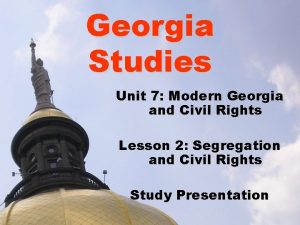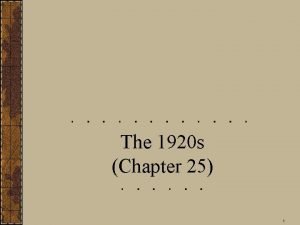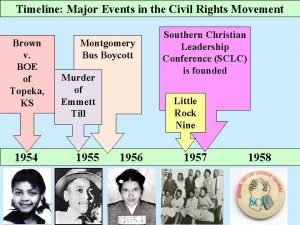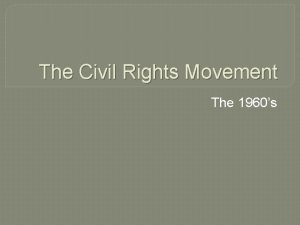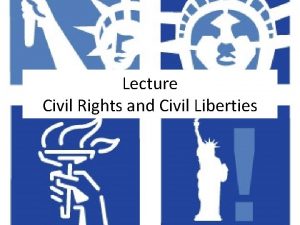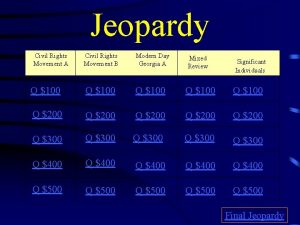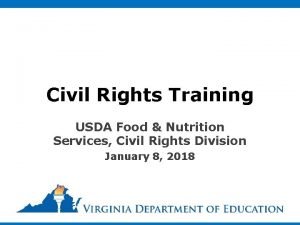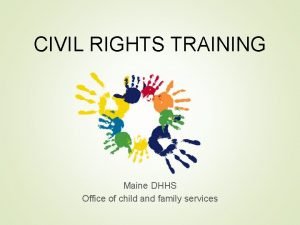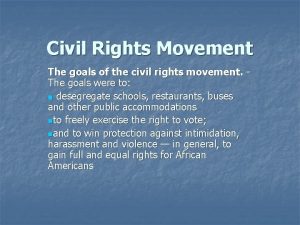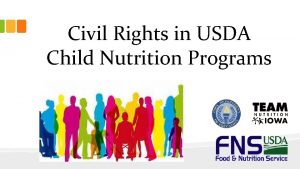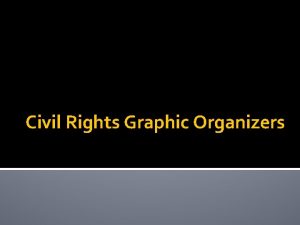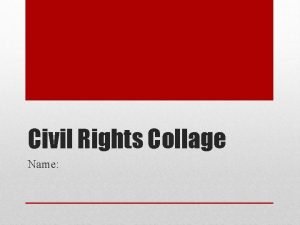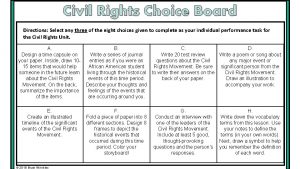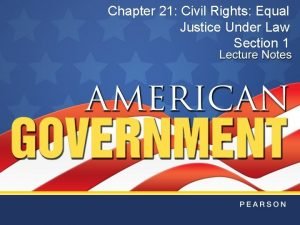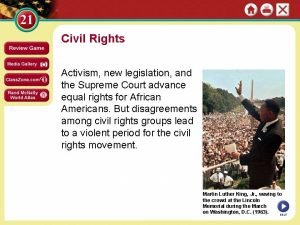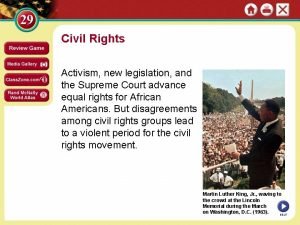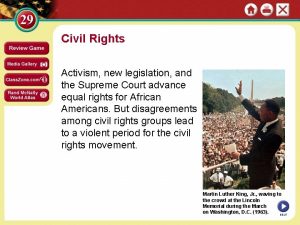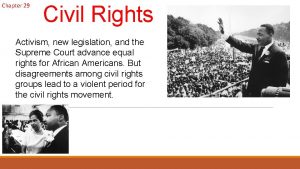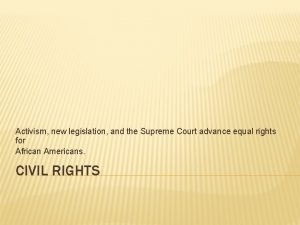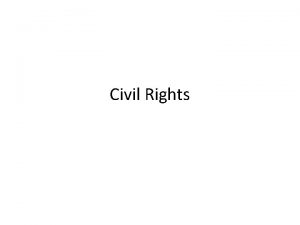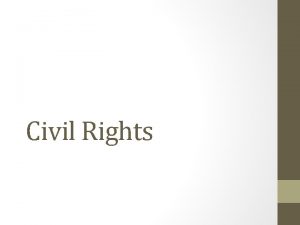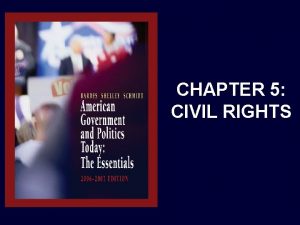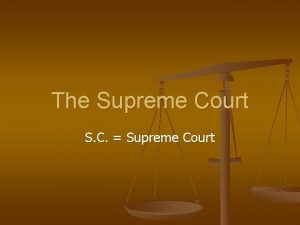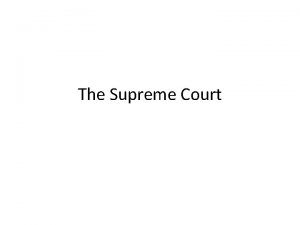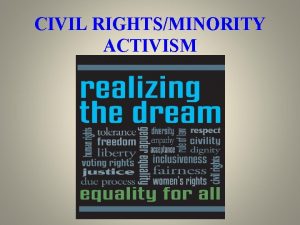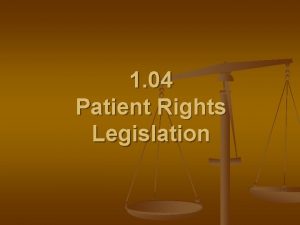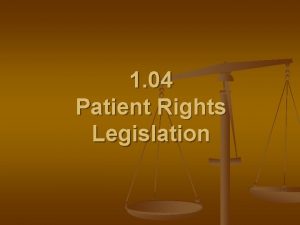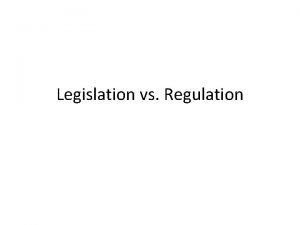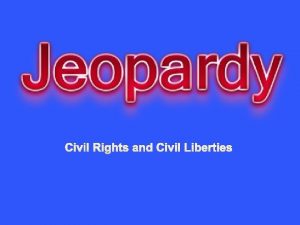Civil Rights Activism new legislation and the Supreme






















- Slides: 22

Civil Rights Activism, new legislation, and the Supreme Court advance equal rights for African Americans. But disagreements among civil rights groups lead to a violent period for the civil rights movement. NEXT

Civil Rights SECTION 1 Taking on Segregation SECTION 2 The Triumphs of a Crusade SECTION 3 Challenges and Changes in the Movement NEXT

Section 2 The Triumphs of a Crusade Civil rights activists break through racial barriers. Their activism prompts landmark legislation. NEXT

Learning Objectives: Section 2 - The Triumphs of a Crusade 1. Identify the goal of the freedom riders. 2. Explain how civil rights activism forced President Kennedy to act against segregation. 3. State the motives of the 1963 March on Washington. 4. Describe the tactics tried by civil rights organizations to secure passage of the Voting Rights Act.

SECTION 2 The Triumphs of a Crusade Riding for Freedom CORE’s Freedom Rides • 1961, CORE tests Court decision banning interstate bus segregation • Freedom riders—blacks, whites sit, use station facilities together • Riders brutally beaten by Alabama mobs; one bus firebombed New Volunteers • Bus companies refuse to continue carrying CORE freedom riders • SNCC volunteers replace CORE riders; are violently stopped • Robert Kennedy pressures bus company to continue transporting riders Continued. . . NEXT

Guided Reading 1. What was the goal of 2. What was the freedom riders? Kennedy administration’s response? To test Supreme Court decisions banning segregation on interstate bus routes and facilities in bus terminals Sent U. S. marshals to protect them; issued an order banning segregation in all interstate travel facilities

MAIN IDEA QUESTIONS • A – What did freedom riders hope to achieve? – They hoped to call attention to the South’s refusal to abandon segregation so as to pressure the federal govt to enforce the Supreme Court’s desegregation rulings.

SECTION 2 continued Riding for Freedom Arrival of Federal Marshals • Alabama officials don’t give promised protection; mob attacks riders • Newspapers throughout nation denounce beatings • JFK sends 400 U. S. marshals to protect riders • Attorney general, Interstate Commerce Commission act: - ban segregation in all interstate travel facilities NEXT

MAIN IDEA QUESTIONS • B – What events led to desegregation in Birmingham? – Days of demonstations; – Arrest of King and others; King’s “letter from Birmingham Jail”; – More demonstration met by arrests and police violence; – Economic boycott

SECTION 2 Standing Firm Integrating Ole Miss • 1962, federal court rules James Meredith may enroll at U of MS • Governor Ross Barnett refuses to let Meredith register • JFK orders federal marshals to escort Meredith to registrar’s office • Barnett makes radio appeal; thousands of white demonstrators riot • Federal officials accompany Meredith to classes, protect his parents Continued. . . NEXT

MAIN IDEA QUESTIONS • C – Why did civil rights organizers ask their supporters to march on Washington? – To spur passage of the civil rights bill

SECTION 2 continued Standing Firm Heading into Birmingham • April 1963, SCLC demonstrate to desegregate Birmingham • King arrested, writes “Letter from Birmingham Jail” • TV news show police attacking child marchers— fire hoses, dogs, clubs • Continued protests, economic boycott, bad press end segregation Kennedy Takes a Stand • June, JFK sends troops to force Gov. Wallace to desegregate U of AL • NAACP’s Medgar Evers murdered; hung juries lead to killer’s release NEXT

MAIN IDEA QUESTIONS • D – Why did civil rights groups organize Freedom Summer? – They hoped to call attention to the lack of voting rights in segregationists stronghold and to promote passage of a federal voting rights act.

SECTION 2 Marching to Washington The Dream of Equality • August 1963, over 250, 000 people converge on Washington • Speakers demand immediate passage of civil rights bill • King gives “I Have a Dream” speech More Violence • September, 4 Birmingham girls killed when bomb thrown into church • LBJ signs Civil Rights Act of 1964 - prohibits discrimination because of race, religion, gender NEXT

Guided Reading 3. What was the goal of the march on Washington? 4. Who attended the march? To persuade Congress to pass 250, 000 civil rights Kennedy's civil rights bill supporters, including 75, 000 whites

SECTION 2 Fighting for Voting Rights Freedom Summer • Freedom Summer—CORE, SNCC project to register blacks to vote in MS • Volunteers beaten, killed; businesses, homes, churches burned A New Political Party • Mississippi Freedom Democratic Party formed to get seat in MS party • Fannie Lou Hamer—voice of MFDP at National Convention—wins support • LBJ fears losing Southern white vote, pressures leaders to compromise • MFDP and SNCC supporters feel betrayed Continued. . . NEXT

Guided Reading 5. What was the goal of the Freedom Summer project? 6. Who volunteered for the project? To register African. American voters who could elect pro-civil rights legislators 1, 000 college students; SNCC staff members

MAIN IDEA QUESTIONS • E – Why did young people in SNCC and the MFDP feel betrayed by some civil rights leaders? – Because the leader agreed to a compromise with the Johnson administration that kept most MFDP delegates from the Democratic convention.

SECTION 2 continued Fighting for Voting Rights The Selma Campaign • 1965, voting rights demonstrator killed in Selma, AL • King leads 600 protest marchers; TV shows police violently stop them • Second march, with federal protection, swells to 25, 000 people Voting Rights Act of 1965 • Congress finally passes Voting Rights Act of 1965 • Stops literacy tests, allows federal officials to enroll voters • Increases black voter enrollment NEXT

Guided Reading 7. What role did the violence shown on television play in this march? 8. What did the march encourage President Johnson to do? convinced people from across the nation to join the marchers To ask Congress for the swift passage of a 1965 Voting Rights bill

MAIN IDEA QUESTIONS • F – In what ways was the civil rights campaign in Selma similar to the one in Birmingham? – In both the campaigns, civil rights workers encountered a violent response, – and in both cases, TV coverage of that violence helped force the federal govt to intervene.

Guided Reading 9. What did the Voting Rights Act outlaw? 10. What did the law accomplish? Eliminated the illiteracy test; Tripled the number of stated that federal examiners registered African-American could enroll voters denied voters in the South; suffrage by local officials raised the registration of eligible African-American voters in the U. S. from 10% in 1964 to 60% in 1968
 Civil rights and civil liberties webquest
Civil rights and civil liberties webquest Literary works in period of activism
Literary works in period of activism Impressionism apush
Impressionism apush Unit 7: modern ga and civil rights
Unit 7: modern ga and civil rights Chapter 14 postwar prosperity and civil rights
Chapter 14 postwar prosperity and civil rights Negative rights vs positive rights
Negative rights vs positive rights Conclusion of rights
Conclusion of rights Legal rights vs moral rights
Legal rights vs moral rights Positive rights and negative rights
Positive rights and negative rights Civil rights timeline of events
Civil rights timeline of events Civil rights sitins
Civil rights sitins Rosa parks mother
Rosa parks mother Right to die
Right to die Civil rights movement jeopardy
Civil rights movement jeopardy Usda civil rights training
Usda civil rights training Civil rights training child nutrition programs
Civil rights training child nutrition programs Goals of the civil rights movement
Goals of the civil rights movement Civil rights in child nutrition programs
Civil rights in child nutrition programs Civil rights graphic organizer
Civil rights graphic organizer Civil rights leaders collage
Civil rights leaders collage Civil rights choice board
Civil rights choice board Chapter 21 civil rights equal justice under law
Chapter 21 civil rights equal justice under law Chapter 20 civil liberties protecting individual rights
Chapter 20 civil liberties protecting individual rights



